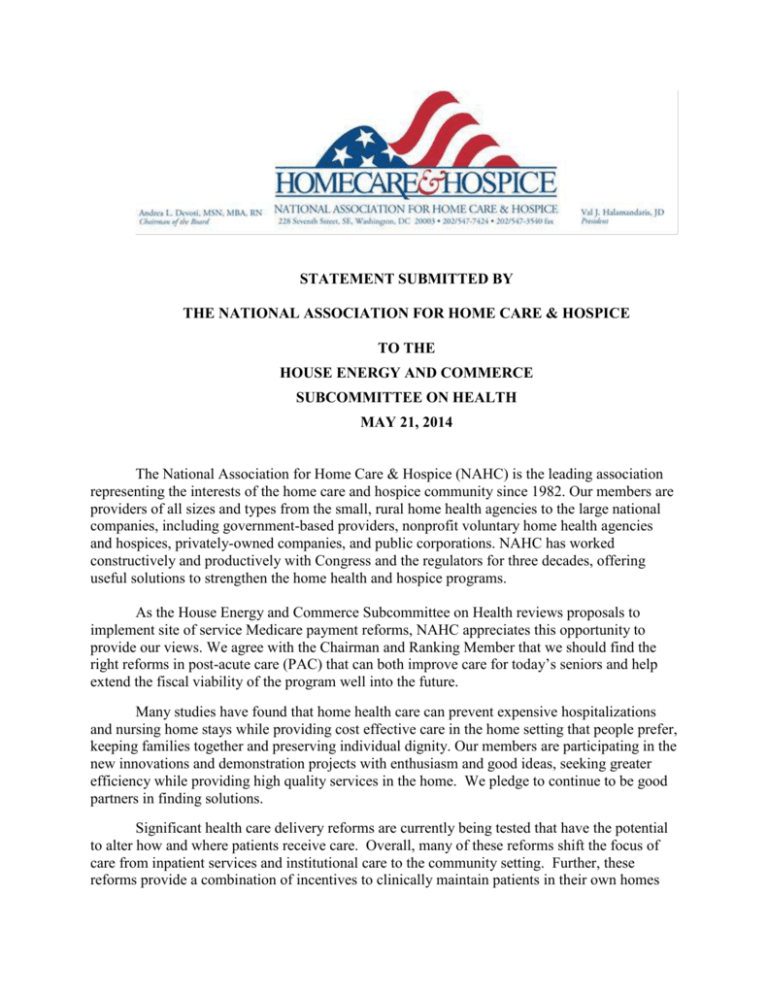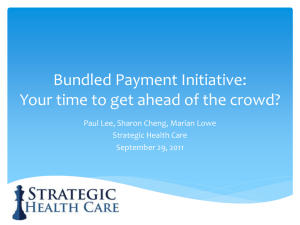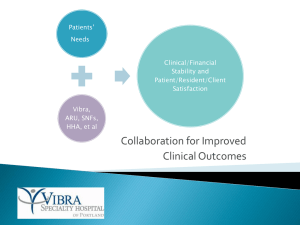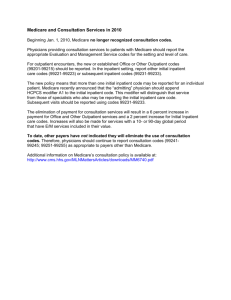Statement Submitted to Energy and Commerce Subcommittee on
advertisement

STATEMENT SUBMITTED BY THE NATIONAL ASSOCIATION FOR HOME CARE & HOSPICE TO THE HOUSE ENERGY AND COMMERCE SUBCOMMITTEE ON HEALTH MAY 21, 2014 The National Association for Home Care & Hospice (NAHC) is the leading association representing the interests of the home care and hospice community since 1982. Our members are providers of all sizes and types from the small, rural home health agencies to the large national companies, including government-based providers, nonprofit voluntary home health agencies and hospices, privately-owned companies, and public corporations. NAHC has worked constructively and productively with Congress and the regulators for three decades, offering useful solutions to strengthen the home health and hospice programs. As the House Energy and Commerce Subcommittee on Health reviews proposals to implement site of service Medicare payment reforms, NAHC appreciates this opportunity to provide our views. We agree with the Chairman and Ranking Member that we should find the right reforms in post-acute care (PAC) that can both improve care for today’s seniors and help extend the fiscal viability of the program well into the future. Many studies have found that home health care can prevent expensive hospitalizations and nursing home stays while providing cost effective care in the home setting that people prefer, keeping families together and preserving individual dignity. Our members are participating in the new innovations and demonstration projects with enthusiasm and good ideas, seeking greater efficiency while providing high quality services in the home. We pledge to continue to be good partners in finding solutions. Significant health care delivery reforms are currently being tested that have the potential to alter how and where patients receive care. Overall, many of these reforms shift the focus of care from inpatient services and institutional care to the community setting. Further, these reforms provide a combination of incentives to clinically maintain patients in their own homes and penalties for excessive re-hospitalizations of patients. Importantly, these reforms also focus on individuals with chronic illnesses, providing support for health care that prevents acute exacerbations of their conditions and avoids both initial and repeat hospitalizations. We believe the demonstration projects testing many new integrated care models and payment structures will provide valuable guidance on how to reform the post acute care system. We also appreciate that the “Bundling and Coordinating Post-Acute Care Act of 2014” (BACPAC) offers a model that adds to the dialogue on how to reform post acute care. Below are several proposals that we believe could help achieve the evidence-based reform that realizes the promise of cost-effective, clinically appropriate care structures that avoid expensive institutional care. a. Post-Acute Community Based Care Bundling: Improving Care Transitions and Maximizing PAC We believe it is important that bundling arrangements for PAC allow PAC providers to hold and administer the risk-adjusted PAC benefit, not the acute care provider. The expertise related to managing patients in a post-acute setting lies with PAC providers, not hospitals, and the payment and accountability should be structured to reflect that. We are encouraged that CMS is testing a post-acute care bundling program where all provider payments are managed by home health agencies. We believe this will ultimately deter unnecessary re-hospitalizations, thus reducing administrative burden and cost. This approach is comparable to the tried and tested Medicare hospice program where payment is bundled to a community-based hospice program where hospitalization is the exception rather than standard practice. Given the evidence regarding the importance of involving home health providers early in the care transitions process, the most effective bundling model would integrate home health providers into the hospital discharge planning process upon the admission of a qualified patient to the hospital. The home health agency would be responsible for a comprehensive evaluation and PAC planning process that is designed to determine whether a patient is medically appropriate and feasible for discharge to the community. Where the home health agency, in close coordination with the hospital, determines that community based care is not appropriate immediately upon hospital discharge, the responsibility for discharge to a post-acute inpatient setting is returned to the hospital. At that point, a postacute inpatient care bundling may be triggered, if available. With this model, the home health agency is responsible for any community-based care related to the patient’s inpatient treatment including home health services, physician services, outpatient rehabilitation services, and any intervening stay in an inpatient rehabilitation facility (IRF), long term care hospital (LTCH), or skilled nursing facility (SNF). Post-acute inpatient stays immediately following hospital discharge are outside of the home health agency responsibility. Benchmarks could be based on existing measurements of quality and patient outcomes in combination with cost avoidance outcomes that relate to re-hospitalizations and use of emergent care. Under a post-acute community based care bundling approach, providers would receive a case mix related per capita payment that is calculated on the basis of the combination of services in the bundle, adjusted for performance in a positive or negative manner. One key aspect of making a bundled payment work is ensuring the technological means to share information among providers. Seamless care transitions depend on physicians, hospitals and home health agencies having access to patient information. The home care community has been an integral partner within the Standards and Interoperability (S&I) Community-Led Initiatives, such as the Longitudinal Coordination of Care (LCC) workgroup, to develop standards for interoperable transitions of care and care plans additions to the Consolidated Clinical Document Architecture (CCDA). Our goal is to leverage the support of these important editions to the CCDA to encourage the adoption of electronic health records (EHR) and also to support the interoperable exchange of health information that is the foundation for building new models of care delivery in home care. b. Value-Based Purchasing Proposal: Improving Performance & Achieving Savings MedPAC recommended application of a “pay for performance” system for home health and other Medicare provider payments. Starting in 2008, Medicare began the Medicare Home Health Agency Pay for Performance Demonstration project operating in seven states. Under the demonstration, home health agencies qualified for incentive payments based on high quality of care performance or improvement in performance from the previous year. The incentive payments are based upon the impact that the performance has had on reducing Medicare costs in other health care sectors, including hospital care. This approach recognizes the dynamic value that high quality home health services can have in reducing overall health care spending. CMS shared more than $15 million in savings with 166 home health agencies based on their performance during the first year of the Medicare Home Health Pay for Performance demonstration in 2009. Another $15 million in savings was shared with the agencies in 2010. As a result of the demonstration’s success, we believe that the Committees should consider authorizing a program that provides performance-based incentive payments to home health providers, taking into account readmissions rates and adherence to quality measures. Unlike the CMS demonstration, the proposal we are putting forth contains both “carrots” and “sticks,” i.e. home health agencies will see reductions in reimbursements if quality metrics are not met. If implemented, we believe this proposal could produce $2.5 billion in direct savings over 10 years. The estimate is based on a CBO projected spend of $250 billion between 2014 and 2023. This estimate does not include the savings that the CMS demonstration showed would be generated from deterred impatient services. We believe overall Medicare savings, outside of the direct savings we propose, would be at least $600 million in the first year and more than $7 billion over ten years. That is calculated roughly based on demonstrated savings from the CMS initiative. The Medicare Home Health Agency Pay for Performance Demonstration showed $15M in savings with 166 HHAs. Currently, there are over 12,000 HHAs. If we conservatively assume that those HHAs generate a half of such savings, we would be looking at $50,000 per HHA in 2014 X 12,000 HHAs= $600M. Alternatively, if you assume that half of the HHAs garner equivalent savings to those in the demonstration it would come to the same dollar result. This estimate includes a small annual increase in savings due to the higher payments rates annually to hospitals, etc. and growth in Medicare enrollment. We do not propose this value-based purchasing arrangement lightly, and given the drastic cuts in home health payments since 2009, we are hesitant about offering a payment withhold. However, we believe strongly that cuts must not be blunt or arbitrary. They must incentivize quality and maintain access to critical services for beneficiaries. Proposal: Implement a 1.5 percent reduction in payments to skilled home health services over a 10 year period; Assess the total performance of a skilled home health provider using a methodology developed by the HHS Secretary and based on the Home Care Compare Hospital Rate and Emergent Care Rate established during the performance period, taking readmissions into account; Determine quality incentive payments for a skilled home health provider using the median performance score of all home health agencies, using a sliding scale such as: o Scores equal to or greater than 75 percentile nationwide would receive a quality incentive payment equal to the full 1.5 percent withheld plus an additional 1 percent payment; o Scores equal to or greater than median, but less than the 75 percentile nationwide would receive a quality incentive payment equal to the full 1.5 percent amount withheld plus an additional .25 percent payment; o Scores equal to or greater than the 25 percentile median, but less than the median score nationwide, would receive a quality incentive payment equal to 50 percent of the amount withheld; and o Scores below the 25 percentile shall not be eligible to receive a quality incentive payment and will have no opportunity to recoup the 1.5 percent cut. The Secretary should be given the opportunity to develop a waiver to ensure access to care, particularly for those living in health professional shortage areas. Any legislative action in this area must be fair in its assessment of the quality of care provided to home health patients and incorporate pending changes to the OASIS assessment tool, as well as a mix of process and outcome measures. It should also be appropriately risk-adjusted and limit any expansion of data collection requirements and fully reimburse agencies for the costs of any additional data collection requirements that are imposed. c. Telehealth Risk-Sharing Proposal: Reducing Inpatient Care through Technology We believe that the use of telehealth should be a high priority as Congress considers evidence-based reform proposals to advance the nation on the fast track toward a highly functioning, technologically enabled, modernized health care delivery system. When deployed in the home as a service of home health care, remote patient monitoring technologies greatly enhance the cost savings potential of PAC. Seniors are able to remain in their homes longer, delaying costly transfers to higher acuity settings, are more engaged with their care and have higher levels of care satisfaction. Providers are able to better manage the care of patients with chronic conditions by monitoring changes in health status with increased frequency and employing advanced analytic tools and data trends to improve service delivery, care coordination and reduce unnecessary emergency room visits and hospital admissions. These benefits have already been demonstrated in a number of home health agencies across the country. When telehomecare interventions for chronically ill Medicaid patients were deployed at Windsor Place Home Health in Windsor, Kansas, for example, hospital readmissions, emergency room visits and nursing home admissions were reduced to zero over a one year period. Total cost savings over the same time period were approximately $1.3 million, while the per patient cost of the intervention was just $6 per patient per day. Similarly, at Forrest General Home Care and Hospice in Mississippi, targeted telehomecare interventions for patients with congestive heart failure and chronic obstructive pulmonary disease caused hospitalization rates to drop from 20 percent to 3 percent and emergent care rates to fall from 7 percent to 2.5 percent over the course of a year. We believe that results like those seen in Kansas and Mississippi could be experienced on a large scale if Medicare reimbursement policies supported the targeted use of telehealth in the home for both homebound patients and chronically ill patients who would benefit from “preacute” homecare. To that end, we recommend that Congress consider legislation providing authority to CMS to test the value of care models that rely on the use of telehealth in home care settings. One such bi-partisan legislative proposal is the Fostering Independence Through Technology Act of 2013 (S. 596), introduced by Senators Amy Klobuchar and John Thune. It would provide authority for CMS to implement a shared savings pilot program for home care agencies using remote patient monitoring technology. Under this legislation, participating agencies would receive a 75 percent share of the total Medicare cost savings realized over a year relative to a performance target set by the Secretary of HHS. The legislation limits payments to the amount that would have otherwise been expended if the pilot project had not been implemented, making this proposal cost-neutral. This integration of telehealth combined with the use of health information technology would greatly modernize the service delivery of home health care and provide for additional cost savings. d. Home-based Chronic Care Model – Integrated Care Model The Home-based Chronic Care Model is a patient-centered, evidence-based model with care coordinated and supported across providers, sectors, and time. This model would benefit both homebound post-acute patients and pre-acute chronically ill patients. However, its real promise and source of cost savings lies in keeping chronically ill patients out of inpatient settings. The model is a partnership between home health agencies and patient centered medical homes that more fully treat the “whole” patient. The home health agency shares responsibility for patient outcomes with the primary care provider. The home health agency carries out the physician care plan and orders for guideline-level assessments and therapies (i.e. blood glucose monitoring, lipid analysis, flu and pneumonia vaccines.) The home health provider also conducts in-home health coaching, motivational interviewing and patient education, as well as provides ongoing support and monitoring. Over time, the Home-based Chronic Care Model has evolved to incorporate new evidence, including a greater focus on patient empowerment and patient-centered care principles and methods to support care transitions. This model is now referred to as the “Integrated Care Model,” (ICM) as best practices are integrated into model tenets and care is integrated across providers and settings. We encourage the Committees to look at integrated care models that include home health care at the center as a way to improve care and reduce costs. Following are three specific homecare agency results from implementing ICM as a care delivery model: Baptist Health Home Health Network, Little Rock, Arkansas The ICM program was initially implemented in one HHA in 2007. Specific outcomes in re-hospitalization rates and patient satisfaction were tracked over 2,000 patients. At this agency, re-hospitalization rates declined from 29 percent to 13 percent, and patient satisfaction increased from 93 percent to 97 percent the year following training. The ICCM model’s authors have described model focus areas, outcomes data, and lessons learned in articles published in peer review journals (Suter, et al., 2008; Hennessey, et al., 2010), and this work was highlighted in a Joint Commission Case Study ( 2009). FirstHealth Home Care , North Carolina FirstHealth has embedded ICM best practices across a continuum of services in their system, including complex care management and telehomecare. Standardizing the delivery of care for patients with chronic disease led to the development of clinical pathways that incorporate the principles of ICM and also include use of the Patient Activation Measure and specific nutritional and therapy interventions for patients with heart failure, COPD, diabetes and cardiac surgery. This approach has led to significant improvement in the home health hospitalization rate as well as the home health 30 day hospitalization rate as noted below: (fiscal year 2011, 2012 are October through September; 2013 is year to date October through June) Home Health Hospitalization Rate (data not risk adjusted) 2011 2012 2013 26.47% 23.87% 20.76% Home Health 30 day Re-hospitalization Rate (data not risk adjusted) 2011 2012 2013 17.41% 16.92% 10.85% White County Medical Center Home Health , Searcy, Arkansas The White County Medical Center Home Health trained all their clinical staff in ICM starting in 2011. They utilize ICM best practices in home care, care transitions, and for care coordination with other team members including physicians, pharmacists, and hospital case managers. Having a chronic care management program and requisite staff competencies has led to significant improvement in their acute care hospitalization (ACH) rates. The risk adjusted ACH rate has improved from 24.4 percent in June 2011 to 12.9 percent in April 2013. The agency is currently in the 1st percentile for the state rankings and 3rd in the nation for preventing acute care hospitalizations.





